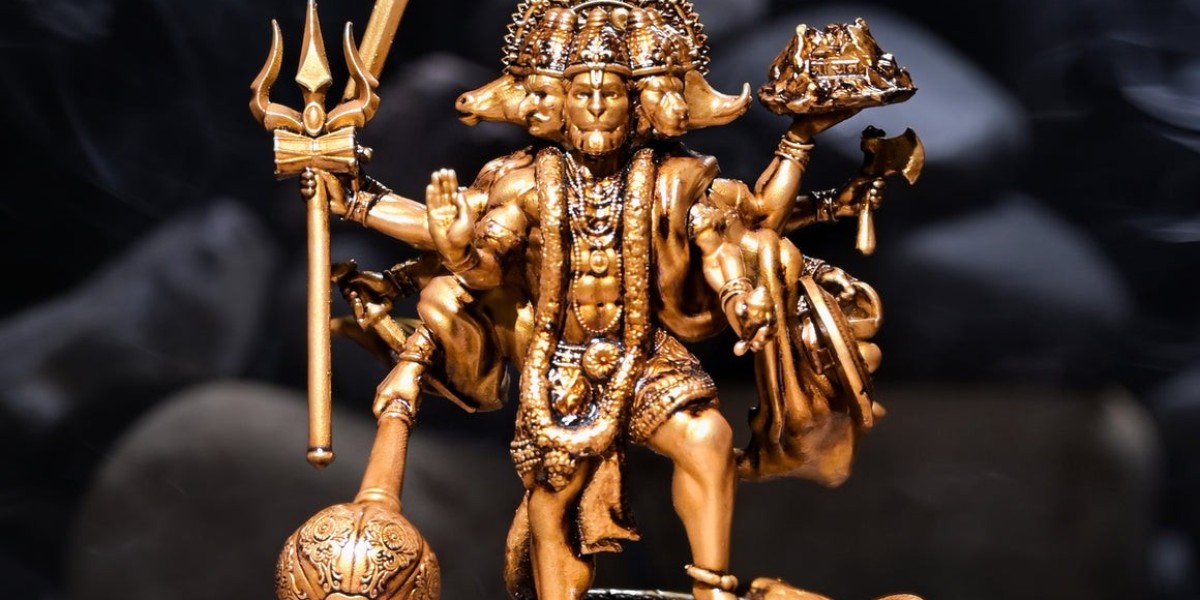Panchmukhi Hanuman Ji, a five-faced manifestation of Lord Hanuman, holds a special place in Hindu mythology and religious practices. Known for his unparalleled devotion to Lord Rama, immense strength, and undying loyalty, Hanuman Ji is worshipped by millions of devotees across the world. The Panchmukhi form, which depicts Hanuman with five distinct faces, each representing a different aspect of divine power, is revered for its spiritual significance and the protection it offers to devotees. In this article, we will delve deep into the origins, symbolism, and the significance of Panchmukhi Hanuman Ji, as well as the rituals and benefits associated with worshiping this powerful deity.
The Origins of Panchmukhi Hanuman Ji
The Panchmukhi Hanuman Ji form is believed to have originated from an episode in the Ramayana, one of the most revered epics in Hinduism. According to legend, during the battle between Lord Rama and the demon king Ravana, Ravana's brother, Ahiravana, kidnapped Lord Rama and his brother Lakshmana and took them to the netherworld (Patal Lok). To rescue them, Lord Hanuman assumed the Panchmukhi form, with five faces pointing in different directions. Each face represented a different deity, and together, they enabled Hanuman to conquer the powerful Ahiravana and save Lord Rama and Lakshmana.
The five faces of Panchmukhi Hanuman Ji are as follows:
Hanuman (East-facing): This is the main face and represents the powerful and fearless warrior aspect of Hanuman. It signifies courage, strength, and protection.
Narasimha (South-facing): The face of Narasimha, an incarnation of Lord Vishnu, symbolizes the destruction of evil and protection from enemies. It is associated with fearlessness and righteousness.
Garuda (West-facing): The face of Garuda, the mighty bird and vehicle of Lord Vishnu, represents power, speed, and the ability to overcome obstacles. It also signifies protection from black magic and evil forces.
Varaha (North-facing): The face of Varaha, the boar incarnation of Lord Vishnu, symbolizes the restoration of balance and the protection of the Earth. It is associated with wealth, prosperity, and the elimination of negative influences.
Hayagriva (Upward-facing): The face of Hayagriva, the horse-headed incarnation of Lord Vishnu, is revered for its association with knowledge, wisdom, and spiritual enlightenment. It also represents protection from harm and guidance in life's journey.
Symbolism and Significance of Panchmukhi Hanuman Ji
The Panchmukhi Hanuman Ji form is rich in symbolism and carries profound spiritual significance. Each face represents a different aspect of divine power and protection, making this form of Hanuman an embodiment of ultimate strength, knowledge, and benevolence. The five faces together symbolize the ability to see and protect in all directions—East, West, North, South, and upwards—indicating omnipresence and omnipotence.
The five faces also represent the five elements (Pancha Bhootas)—earth, water, fire, air, and space—signifying that Hanuman is the master of these elements and has control over the physical and spiritual realms. The combination of these faces into one deity also signifies the unity and harmony of different divine powers working together for the protection and well-being of devotees.
Worship of Panchmukhi Hanuman Ji
Worshiping Panchmukhi Hanuman Ji is believed to bring numerous benefits, including protection from negative forces, success in endeavors, spiritual growth, and the removal of obstacles. Devotees often install Panchmukhi Hanuman idols or images in their homes, temples, and workplaces to seek the blessings and protection of the deity.
1. Rituals and Practices
Worshiping Panchmukhi Hanuman Ji involves specific rituals and practices to invoke the deity's blessings. Here are some common rituals associated with Panchmukhi Hanuman worship:
Panchamukhi Hanuman Stotra: Reciting the Panchamukhi Hanuman Stotra, a powerful hymn dedicated to this form of Hanuman, is considered highly beneficial. This stotra invokes the protection and blessings of all five faces of Hanuman and is often recited during difficult times to overcome challenges.
Lighting a Lamp: Lighting a lamp with mustard oil or ghee in front of the Panchmukhi Hanuman idol or image is believed to dispel darkness and negative energies from the surroundings. It is a common practice to light a lamp every Tuesday and Saturday, days considered auspicious for Hanuman worship.
Offering Sindoor: Applying sindoor (vermilion) to the idol of Panchmukhi Hanuman is a significant ritual, as it is believed that Hanuman himself is fond of sindoor. Devotees offer sindoor mixed with mustard oil as a mark of respect and to seek Hanuman's blessings for strength and vitality.
Chanting Hanuman Chalisa: The Hanuman Chalisa, a devotional hymn composed by Tulsidas, is often chanted by devotees as part of their daily prayers. Chanting the Hanuman Chalisa is believed to invoke Hanuman's divine presence and provide protection from evil forces.
Offering Prasadam: Devotees offer prasadam (food offerings) such as jaggery, bananas, and coconuts to Panchmukhi Hanuman Ji. These offerings are later distributed among family members and fellow devotees as a form of divine blessings.
2. Festivals and Special Occasions
Hanuman Jayanti, the birthday of Lord Hanuman, is one of the most significant festivals dedicated to Hanuman Ji, including his Panchmukhi form. Devotees across India and other parts of the world celebrate this day with great fervor by performing special prayers, reciting hymns, and organizing processions. On this day, temples dedicated to Hanuman Ji are adorned with flowers, and devotees throng these temples to seek his blessings.
Another important occasion for Panchmukhi Hanuman worship is the day of Diwali, particularly during the festival of Naraka Chaturdashi. On this day, devotees light lamps and offer prayers to Panchmukhi Hanuman Ji to seek protection from negative energies and to overcome obstacles.
3. Installation of Panchmukhi Hanuman Idol
Installing a Panchmukhi Hanuman idol at home or in a temple requires specific rituals to ensure the deity's blessings. It is advisable to consult a priest for the installation ceremony, which typically involves:
Purification: The area where the idol will be installed is cleansed and purified with holy water and Vedic chants to make it suitable for the deity's presence.
Pran Pratishtha: This is a vital ritual where the life force (prana) of the deity is invoked into the idol. The priest performs specific rituals and chants to invite the divine presence of Panchmukhi Hanuman Ji into the idol.
Offering Rituals: After the installation, offerings such as flowers, fruits, sweets, and incense are made to the deity. Devotees then perform aarti (ritual of waving lighted lamps) to conclude the installation ceremony.
Benefits of Worshiping Panchmukhi Hanuman Ji
Worshiping Panchmukhi Hanuman Ji is believed to offer several spiritual and material benefits. Some of the key benefits include:
Protection from Negative Forces: Panchmukhi Hanuman Ji is revered as a powerful protector who shields his devotees from evil spirits, black magic, and negative energies. His presence is believed to create a protective barrier around the worshiper.
Success and Prosperity: Devotees who seek success in their personal and professional lives often turn to Panchmukhi Hanuman Ji for his blessings. It is believed that regular worship of this form of Hanuman brings prosperity, wealth, and success in all endeavors.
Removal of Obstacles: One of the primary reasons devotees worship Panchmukhi Hanuman Ji is to remove obstacles from their path. Whether it is overcoming challenges in career, health, or relationships, the deity is known to provide guidance and solutions.
Spiritual Growth: Worshiping Panchmukhi Hanuman Ji also aids in spiritual growth and self-realization. The deity's wisdom and knowledge, symbolized by his Hayagriva face, inspire devotees to seek higher knowledge and spiritual enlightenment.
Courage and Strength: Hanuman Ji, in all his forms, is a symbol of courage and strength. Worshiping Panchmukhi Hanuman Ji helps devotees build mental and physical strength, enabling them to face life's challenges with confidence and resilience.
Conclusion
Panchmukhi Hanuman Ji, with his five divine faces, represents the ultimate combination of strength, wisdom, and protection. Worshiping this powerful form of Hanuman is a practice that brings immense benefits to devotees, both in their material and spiritual lives. By understanding the significance of each face and following the rituals associated with Panchmukhi Hanuman worship, devotees can invoke his blessings and create a life filled with peace, prosperity, and protection. Whether through daily prayers, special ceremonies, or the installation of an idol at home, the worship of Panchmukhi Hanuman Ji is a path to divine grace and spiritual fulfillment.



